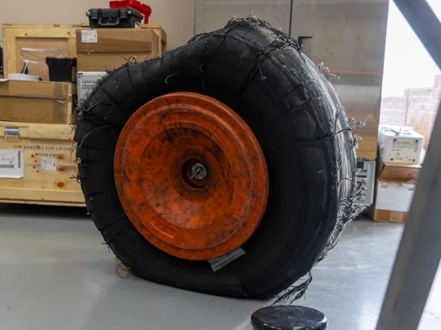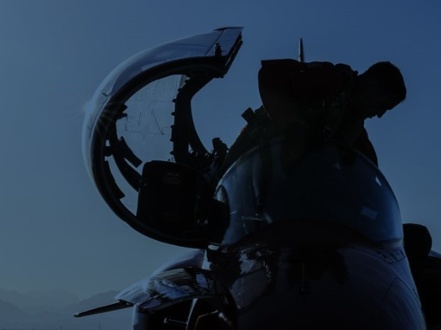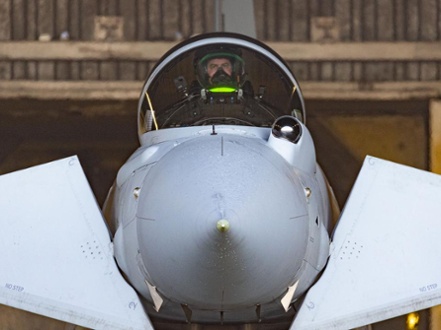Mission accomplished! RAF aircraft and personnel have made a significant contribution to the success of the world’s premier air combat exercise.
The RAF contribution to the exercise consisted of Typhoon fighter jets, a Voyager air-to-air refueler, Rivet Joint electronic surveillance crews, engineers, Air Controllers, Space specialists and a variety of support personnel.
The exercise, involving over 3000 people from the US, UK and Australia, was split into two phases. The first phase was flown from Nellis Air Base in Nevada and gave the international teams the opportunity to plan together and "fight" against real aircraft playing the roles of adversaries in a realistic scenario.
The second phase of the exercise saw the various fighter squadrons disperse to locations along the west coast of the US. From these locations they continued the fight in a huge training area over 500 miles off the US Pacific coast.
The US Air Force maintains a variety of fighter jets dedicated to playing the roles of adversary aircraft. The pilots of these aircraft worked separately to plan how they could achieve their mission objectives using the tactics of the air forces that they were imitating.
The exercise is deliberately challenging and the fighters faced many unknown threats, which they had to work together to defeat.
"It was great to see how we improved during the exercise, this was achieved primarily by enhancing our collective understanding of how to utilise each aircraft type in the most effective possible way."
Flight Lieutenant Tom Raeburn
Typhoon Pilot
The Typhoon pilots on the exercise were predominantly from 3 (Fighter) Squadron, but pilots from several other Typhoon squadrons also participated. This was to ensure that the advancements made during the exercise are rapidly implemented across the RAF's Typhoon Force.
The RAF's Typhoons demonstrated their value and reliability throughout the exercise. As a result of the careful planning and hard work of the engineering team, the Typhoons fulfilled all 120 mission sorties assigned to them.
The Typhoons' power, manoeuvrability and high payload also contributed to the overall success of the missions. The Typhoons integrated with US and Australian F-35 fighters, who utilised their advanced radars to locate targets. The Typhoons were then able to engage the targets with their highly capable long-range missiles.
The Typhoons demonstrated the full range of their capabilities, conducting Defensive Counter Air, Offensive Counter Air, long range strikes, reconnaissance and air interdiction missions. They were able to successfully locate, track and then target a convoy of "enemy" trucks on the ground.
Operating with partners ensures that the RAF is ready to respond collectively to any threats to UK security. The RAF's Air and Space Commander, Air Marshal Harv Smyth visited the exercise with his British Army counterpart, Commander Field Army, Lieutenant General Sir Ralph Wooddisse to discuss the UK's approach to emerging global security threats.
“This exercise pushes the participants to the very limit of their capabilities, but importantly also gives them the opportunity to use all their capabilities. For example, integrating the Typhoon’s Meteor missile with the capabilities of the fifth generation fighters.
In the third week of the exercise all the aircraft took off from Neliis but didn’t land back there, instead they dispersed all over Nevada and California, to continue with the mission. The ability to disperse presents our adversaries with really difficult targeting dilemmas.”
Air Marshal Smyth
Air and Space Commander
The air combat was coordinated by Air Controllers from the UK, US and Australia. RAF personnel were assigned the critical role of Mission Commander, where they were responsible for leading the planning and execution of the entire mission.
"Working with our US and Australian colleagues in this extremely demanding environment has been a very valuable experience. We have learnt a huge amount from each other and formed a very close-knit team."
Squadron Leader Dan Moriarty
Commander of the RAF Air Controller Team
The exercise gave the opportunity to test the full spectrum of air and space capabilities. A team from UK Space Command deployed to embed into the US Air Force Warfare Centre.
"The space capabilities represented on this exercise are second to none. The value for us to integrate, learn, instruct and be evaluated cannot be overstated.”
Squadron Leader Shaw
UK Space Command Team Lead
Electronic surveillance crews from 51 Squadron flew onboard a US Rivet Joint aircraft alongside their US colleagues. UK and US Rivet Joint crews are completely interchangeable, and the RAF crew members were able to use their recent operational experience to mentor US colleagues.








